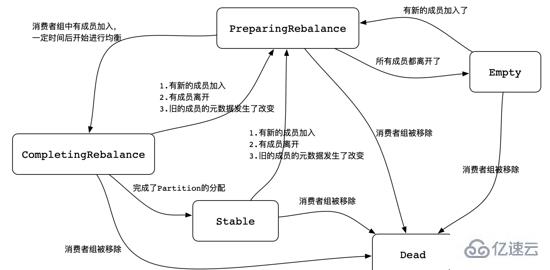您好,登錄后才能下訂單哦!
您好,登錄后才能下訂單哦!
這篇“Kafka心跳與消費機制是什么”文章的知識點大部分人都不太理解,所以小編給大家總結了以下內容,內容詳細,步驟清晰,具有一定的借鑒價值,希望大家閱讀完這篇文章能有所收獲,下面我們一起來看看這篇“Kafka心跳與消費機制是什么”文章吧。
Kafka是通過心跳機制來控制消費超時,心跳機制對于消費者客戶端來說是無感的,它是一個異步線程,當我們啟動一個消費者實例時,心跳線程就開始工作了。心跳超時會導致消息重復消費。

首先,我們來看看消費。Kafka提供了非常簡單的消費API,使用者只需初始化Kafka的Broker Server地址,然后實例化KafkaConsumer類即可拿到Topic中的數據。一個簡單的Kafka消費實例代碼如下所示:
public class JConsumerSubscribe extends Thread {
public static void main(String[] args) { JConsumerSubscribe jconsumer = new JConsumerSubscribe(); jconsumer.start(); } /** 初始化Kafka集群信息. */ private Properties configure() { Properties props = new Properties(); props.put("bootstrap.servers", "dn1:9092,dn2:9092,dn3:9092");// 指定Kafka集群地址
props.put("group.id", "ke");// 指定消費者組
props.put("enable.auto.commit", "true");// 開啟自動提交
props.put("auto.commit.interval.ms", "1000");// 自動提交的時間間隔
// 反序列化消息主鍵 props.put("key.deserializer", "org.apache.kafka.common.serialization.StringDeserializer");
// 反序列化消費記錄 props.put("value.deserializer", "org.apache.kafka.common.serialization.StringDeserializer");
return props;
} /** 實現一個單線程消費者. */ @Override public void run() { // 創建一個消費者實例對象 KafkaConsumer consumer = new KafkaConsumer(configure()); // 訂閱消費主題集合 consumer.subscribe(Arrays.asList("test_kafka_topic"));
// 實時消費標識 boolean flag = true;
while (flag) {
// 獲取主題消息數據 ConsumerRecords records = consumer.poll(Duration.ofMillis(100));
for (ConsumerRecord record : records)
// 循環打印消息記錄 System.out.printf("offset = %d, key = %s, value = %s%n", record.offset(), record.key(), record.value());
} // 出現異常關閉消費者對象 consumer.close();
}}上述代碼我們就可以非常便捷的拿到Topic中的數據。但是,當我們調用poll方法拉取數據的時候,Kafka Broker Server做了那些事情。接下來,我們可以去看看源代碼的實現細節。核心代碼如下: org.apache.kafka.clients.consumer.KafkaConsumer
private ConsumerRecords poll(final long timeoutMs, final boolean includeMetadataInTimeout) {
acquireAndEnsureOpen(); try {
if (timeoutMs "Timeout must not be negative");
if (this.subscriptions.hasNoSubscriptionOrUserAssignment()) {
throw new IllegalStateException("Consumer is not subscribed to any topics or assigned any partitions");
} // poll for new data until the timeout expires
long elapsedTime = 0L;
do {
client.maybeTriggerWakeup(); final long metadataEnd; if (includeMetadataInTimeout) {
final long metadataStart = time.milliseconds(); if (!updateAssignmentMetadataIfNeeded(remainingTimeAtLeastZero(timeoutMs, elapsedTime))) {
return ConsumerRecords.empty();
} metadataEnd = time.milliseconds(); elapsedTime += metadataEnd - metadataStart; } else {
while (!updateAssignmentMetadataIfNeeded(Long.MAX_VALUE)) {
log.warn("Still waiting for metadata");
} metadataEnd = time.milliseconds(); } final Map>> records = pollForFetches(remainingTimeAtLeastZero(timeoutMs, elapsedTime)); if (!records.isEmpty()) {
// before returning the fetched records, we can send off the next round of fetches
// and avoid block waiting for their responses to enable pipelining while the user
// is handling the fetched records.
//
// NOTE: since the consumed position has already been updated, we must not allow
// wakeups or any other errors to be triggered prior to returning the fetched records.
if (fetcher.sendFetches() > 0 || client.hasPendingRequests()) {
client.pollNoWakeup(); } return this.interceptors.onConsume(new ConsumerRecords(records));
} final long fetchEnd = time.milliseconds(); elapsedTime += fetchEnd - metadataEnd; } while (elapsedTime return ConsumerRecords.empty();
} finally {
release(); } }上述代碼中有個方法pollForFetches,它的實現邏輯如下:
private Map>> pollForFetches(final long timeoutMs) {
final long startMs = time.milliseconds();
long pollTimeout = Math.min(coordinator.timeToNextPoll(startMs), timeoutMs);
// if data is available already, return it immediately
final Map>> records = fetcher.fetchedRecords();
if (!records.isEmpty()) {
return records;
}
// send any new fetches (won't resend pending fetches)
fetcher.sendFetches();
// We do not want to be stuck blocking in poll if we are missing some positions
// since the offset lookup may be backing off after a failure
// NOTE: the use of cachedSubscriptionHashAllFetchPositions means we MUST call
// updateAssignmentMetadataIfNeeded before this method.
if (!cachedSubscriptionHashAllFetchPositions && pollTimeout > retryBackoffMs) {
pollTimeout = retryBackoffMs;
}
client.poll(pollTimeout, startMs, () -> {
// since a fetch might be completed by the background thread, we need this poll condition
// to ensure that we do not block unnecessarily in poll()
return !fetcher.hasCompletedFetches();
});
// after the long poll, we should check whether the group needs to rebalance
// prior to returning data so that the group can stabilize faster
if (coordinator.rejoinNeededOrPending()) {
return Collections.emptyMap();
}
return fetcher.fetchedRecords();
}上述代碼中加粗的位置,我們可以看出每次消費者客戶端拉取數據時,通過poll方法,先調用fetcher中的fetchedRecords函數,如果獲取不到數據,就會發起一個新的sendFetches請求。而在消費數據的時候,每個批次從Kafka Broker Server中拉取數據是有最大數據量限制,默認是500條,由屬性(max.poll.records)控制,可以在客戶端中設置該屬性值來調整我們消費時每次拉取數據的量。
**提示:**這里需要注意的是,max.poll.records返回的是一個poll請求的數據總和,與多少個分區無關。因此,每次消費從所有分區中拉取Topic的數據的總條數不會超過max.poll.records所設置的值。
而在Fetcher的類中,在sendFetches方法中有限制拉取數據容量的限制,由屬性(max.partition.fetch.bytes),默認1MB。可能會有這樣一個場景,當滿足max.partition.fetch.bytes限制條件,如果需要Fetch出10000條記錄,每次默認500條,那么我們需要執行20次才能將這一次通過網絡發起的請求全部Fetch完畢。
這里,可能有同學有疑問,我們不能將默認的max.poll.records屬性值調到10000嗎?可以調,但是還有個屬性需要一起配合才可以,這個就是每次poll的超時時間(Duration.ofMillis(100)),這里需要根據你的實際每條數據的容量大小來確定設置超時時間,如果你將最大值調到10000,當你每條記錄的容量很大時,超時時間還是100ms,那么可能拉取的數據少于10000條。
而這里,還有另外一個需要注意的事情,就是會話超時的問題。session.timeout.ms默認是10s,group.min.session.timeout.ms默認是6s,group.max.session.timeout.ms默認是30min。當你在處理消費的業務邏輯的時候,如果在10s內沒有處理完,那么消費者客戶端就會與Kafka Broker Server斷開,消費掉的數據,產生的offset就沒法提交給Kafka,因為Kafka Broker Server此時認為該消費者程序已經斷開,而即使你設置了自動提交屬性,或者設置auto.offset.reset屬性,你消費的時候還是會出現重復消費的情況,這就是因為session.timeout.ms超時的原因導致的。
上面在末尾的時候,說到會話超時的情況導致消息重復消費,為什么會有超時?有同學會有這樣的疑問,我的消費者線程明明是啟動的,也沒有退出,為啥消費不到Kafka的消息呢?消費者組也查不到我的ConsumerGroupID呢?這就有可能是超時導致的,而Kafka是通過心跳機制來控制超時,心跳機制對于消費者客戶端來說是無感的,它是一個異步線程,當我們啟動一個消費者實例時,心跳線程就開始工作了。
在org.apache.kafka.clients.consumer.internals.AbstractCoordinator中會啟動一個HeartbeatThread線程來定時發送心跳和檢測消費者的狀態。每個消費者都有個org.apache.kafka.clients.consumer.internals.ConsumerCoordinator,而每個ConsumerCoordinator都會啟動一個HeartbeatThread線程來維護心跳,心跳信息存放在org.apache.kafka.clients.consumer.internals.Heartbeat中,聲明的Schema如下所示:
private final int sessionTimeoutMs; private final int heartbeatIntervalMs; private final int maxPollIntervalMs; private final long retryBackoffMs; private volatile long lastHeartbeatSend; private long lastHeartbeatReceive; private long lastSessionReset; private long lastPoll; private boolean heartbeatFailed;
心跳線程中的run方法實現代碼如下:
public void run() {
try {
log.debug("Heartbeat thread started");
while (true) {
synchronized (AbstractCoordinator.this) {
if (closed)
return;
if (!enabled) {
AbstractCoordinator.this.wait();
continue;
} if (state != MemberState.STABLE) {
// the group is not stable (perhaps because we left the group or because the coordinator
// kicked us out), so disable heartbeats and wait for the main thread to rejoin.
disable();
continue;
}
client.pollNoWakeup();
long now = time.milliseconds();
if (coordinatorUnknown()) {
if (findCoordinatorFuture != null || lookupCoordinator().failed())
// the immediate future check ensures that we backoff properly in the case that no
// brokers are available to connect to.
AbstractCoordinator.this.wait(retryBackoffMs);
} else if (heartbeat.sessionTimeoutExpired(now)) {
// the session timeout has expired without seeing a successful heartbeat, so we should
// probably make sure the coordinator is still healthy.
markCoordinatorUnknown();
} else if (heartbeat.pollTimeoutExpired(now)) {
// the poll timeout has expired, which means that the foreground thread has stalled
// in between calls to poll(), so we explicitly leave the group.
maybeLeaveGroup();
} else if (!heartbeat.shouldHeartbeat(now)) {
// poll again after waiting for the retry backoff in case the heartbeat failed or the
// coordinator disconnected
AbstractCoordinator.this.wait(retryBackoffMs);
} else {
heartbeat.sentHeartbeat(now);
sendHeartbeatRequest().addListener(new RequestFutureListener() {
@Override
public void onSuccess(Void value) {
synchronized (AbstractCoordinator.this) {
heartbeat.receiveHeartbeat(time.milliseconds());
}
}
@Override
public void onFailure(RuntimeException e) {
synchronized (AbstractCoordinator.this) {
if (e instanceof RebalanceInProgressException) {
// it is valid to continue heartbeating while the group is rebalancing. This
// ensures that the coordinator keeps the member in the group for as long
// as the duration of the rebalance timeout. If we stop sending heartbeats,
// however, then the session timeout may expire before we can rejoin.
heartbeat.receiveHeartbeat(time.milliseconds());
} else {
heartbeat.failHeartbeat();
// wake up the thread if it's sleeping to reschedule the heartbeat
AbstractCoordinator.this.notify();
}
}
}
});
}
}
}
} catch (AuthenticationException e) {
log.error("An authentication error occurred in the heartbeat thread", e);
this.failed.set(e);
} catch (GroupAuthorizationException e) {
log.error("A group authorization error occurred in the heartbeat thread", e);
this.failed.set(e);
} catch (InterruptedException | InterruptException e) {
Thread.interrupted();
log.error("Unexpected interrupt received in heartbeat thread", e);
this.failed.set(new RuntimeException(e));
} catch (Throwable e) {
log.error("Heartbeat thread failed due to unexpected error", e);
if (e instanceof RuntimeException)
this.failed.set((RuntimeException) e);
else
this.failed.set(new RuntimeException(e));
} finally {
log.debug("Heartbeat thread has closed");
}
}在心跳線程中這里面包含兩個最重要的超時函數,它們是sessionTimeoutExpired和pollTimeoutExpired。
public boolean sessionTimeoutExpired(long now) {
return now - Math.max(lastSessionReset, lastHeartbeatReceive) > sessionTimeoutMs;
}public boolean pollTimeoutExpired(long now) {
return now - lastPoll > maxPollIntervalMs;
}如果是sessionTimeout超時,則會被標記為當前協調器處理斷開,此時,會將消費者移除,重新分配分區和消費者的對應關系。在Kafka Broker Server中,Consumer Group定義了5中(如果算上Unknown,應該是6種狀態)狀態,org.apache.kafka.common.ConsumerGroupState,如下圖所示:

如果觸發了poll超時,此時消費者客戶端會退出ConsumerGroup,當再次poll的時候,會重新加入到ConsumerGroup,觸發RebalanceGroup。而KafkaConsumer Client是不會幫我們重復poll的,需要我們自己在實現的消費邏輯中不停的調用poll方法。
關于消費分區與消費線程的對應關系,理論上消費線程數應該小于等于分區數。之前是有這樣一種觀點,一個消費線程對應一個分區,當消費線程等于分區數是最大化線程的利用率。直接使用KafkaConsumer Client實例,這樣使用確實沒有什么問題。但是,如果我們有富裕的CPU,其實還可以使用大于分區數的線程,來提升消費能力,這就需要我們對KafkaConsumer Client實例進行改造,實現消費策略預計算,利用額外的CPU開啟更多的線程,來實現消費任務分片。
以上就是關于“Kafka心跳與消費機制是什么”這篇文章的內容,相信大家都有了一定的了解,希望小編分享的內容對大家有幫助,若想了解更多相關的知識內容,請關注億速云行業資訊頻道。
免責聲明:本站發布的內容(圖片、視頻和文字)以原創、轉載和分享為主,文章觀點不代表本網站立場,如果涉及侵權請聯系站長郵箱:is@yisu.com進行舉報,并提供相關證據,一經查實,將立刻刪除涉嫌侵權內容。